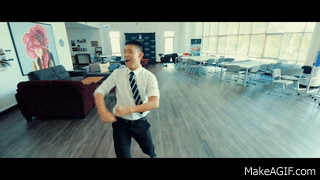Nobody will ever notice that. Filmmaking is not about the tiny details.
It's about the big picture
ed wood
THERE ARE LOADS OF COOKIES BELOW.
PLEASE
REFRESH AT LEAST TWICE
BEFORE SURFING TO ENSURE ALL CONTENT
THERE ARE LOADS OF COOKIES BELOW.
PLEASE
REFRESH AT LEAST TWICE
BEFORE SURFING TO ENSURE ALL CONTENT
DEVELOPMENT OF IDEA





Research; Now at the stage where I have researched theories and concepts to support and justify its influence in our short film, the elements of knowledge will now be combined in the Development of Idea section to outline and carve the perfect vision of the film.
PRE - PRODUCTION
INITIAL DISCUSSION
Sunday 2nd September 2017
Plans and Mind-maps
Tuesday 4th September 2017
A rough sketch of a storyboard, highlighting the main events in the film's narrative.

We decided to discuss our broad ideas of the short film coursework- alike ingredients- and slowly forming (I'm keeping a note record) the perfect dish.
We tried tackling the genre of survival drama, and although Toy's idea and vision for this were promising, we concluded that it was too problematic to arrange filming locations, and I did not feel it was in my creative forte to make such films in the genre.
The main aspects of what we thought were required in a short film; a message(s), the genre/theme, and any media or film-making details should be in the film


HOWEVER
ROUGH
There have been a change of plans into the genre of
our short film: Comedy. After at least 3 weeks of exploring,
conducting primary research, planning and storyboarding the initial cyber bullying film, we have decided that it was too much work to pull something off so far away from all of us, and that the final media product may not represent the feelings and emotional shape of a cyber-bullying victim to the point of suicide. Resources are also limited, actors may not be able to convey the wanted emotion... therefore we had changed the focus to something we are already familiar with (Uses and Gratifications Theory), on a lighter and brighter genre of comedy with one actor only.
A NEW PATH
A Comedy Short Film for A2 Media 2017-18




Friday 22nd September 2017
INITIAL DISCUSSION

Fig 1.1 The Dream Team
Plans and Mind-maps
Tuesday 26th September 2017
Ryu was not in school today, so Toy and I decided to have a developed conversation beyond the discussion video above. Not only did we catch-up on the story-line, we had also discussed our message of the film, as well as our driving force that will shape and become the basis of the media product, which was decided to be Blumler and Katz's Uses and Gratifications theory.
To not leave Ryu out, I decided to Facebook call him from his house (he was at the Travel and Tourism Trip) and we had outlined the theory and after long thought and pitching of ideas, we came up with the 4 acts in ur short film; every act depicting a new everyday task that are "gratification sources" for the protagonist.


The Mood Board
Wednesday 27th September 2017


Fig 1.2 An afternoon discussion
Accumulating our diverse ideas for the film through various forms, we had sat down one afternoon to compile and visually summarize the main themes, motifs and messages in our short film. The result was a mood board that depicts some latent, and meanwhile some manifest aspects of the media product we are making.
DETAILED DISCUSSION
Wednesday 27th September 2017
Catching up with Toy about the initial discussion Ryu and I had a few days ago, we summarize the overview of the short film and even came up, together, with more specific ideas to our media product. Hence the obstacles of the two having resits in the next two weeks, we have decided that this was the perfect opportunity to focus mainly on planning and story-boarding before production. This will ensure that when production times occur, everything will be noted and will run smoothly.
Brief Timeline of Media A2 Short Film
Thursday 28th September 2017
After a reunion with the dream team, we decided to not create a storyboard solely, but an overall timeline of not only the main events of the film, but also explanation and description of specific shot types and media techniques, the meaning intended to create, and the application of various research modules.


TOILET SCENE: Prep School Adults Restroom

LOCATION
SCOUTING









Relate; A large-sized toilet will serve as the third gratification source of the protagonist when he is stopped by the possessed toiletries (by the society entity) as he is in the process of relieving himself as another form of physical gratification.
Strength; The location is spacious, and meets the requirements of having three stalls (to the plot). In addition, other facilities such as the urinals and sinks also come in threes, providing the institutional and fixed meaning of a controlled and manipulated society that we desire.
Moreover, the location is large and flexible- especially for the cinematographer- who will be able to achieve new and unconventional perspectives and shot types from different heights, angles, and depths of field with the space given.
Limitation; The location is a staff toilet, therefore paperwork, permissions, and informed consent need to be obtained beforehand. This will be time-consuming as opposed to filming a student toilet instead.


INTRO: Second School Entrance


Relate; An outdoor space that will, through an establishing shot, suggest the qualities of a school with the mise-en scenes such as a school gate, security posts, student-crossing signs, fences... etc.
Strength; The location is perfect for the short film. It is everything we are looking for: the correct and appropriate mise-en scene, easy accessibility (it is located next to the Sixth Form Centre), as well as being less problematic due to the majority of cars passing through the main entrance and not this one. So, more accessibility, filming times and more safer compared to other main or common entrances.
Limitation; The location is a professional gate which will always be on duty by the security staff. Therefore, to film here we will need to formally file paperwork for permission, as well as health and safety forms, with an approved consent form and the signatures of the heads- very time consuming, but worth it.


FOOD SCENE: The Dining Hall




Relate; An indoor location with accessibility (in reach) of a dining table with chairs, cups and bowls, kitchen commonalities, and large white walls in the interior; used for the parallel editing.
Strength; The Dining Hall exceeds the criteria we are looking for with its mise-en scene that will strongly imply the presence of an eating area. There are also various forms and many available tables in different corners that we can play to our strengths during production; going to a quiet corner to film the scene without disruption.
Limitation; The location is a professional work-place that is always active in preparing, serving and cleaning food for the students and staff. Therefore, we may have to book appropriate times during our free periods to tackle the problem of filming while they are in the middle of service, or worse, a health hazard of filming and running into staff carrying hot liquids in rush hour.


SOCIAL SCENE: The Sixth Form Centre


Relate; An indoor location with the connotation of an area with senior (preferably sixth form students) working and socializing together. The students should also be present to suggest a place of community with the similar age as the protagonist, who at this point, is trying to fit in, in order to receive the gratification of belonging with people.
Strength; The Sixth Form centre is the only suitable place for this as it is exactly the purpose we are looking for. There are also many variations in how students place themselves to provide a balanced overview shot of many groups belonging to each other throughout the whole centre (metaphor of society).
Limitation; Even with a constant flow of students, which is beneficial as a backdrop and establishing shot to suggest social groups, this may potentially become a huge issue, editing-wise. As people are always constantly moving and the same scene is required to be shot in different angles, editing loop-holes of people teleporting in the background will distract the audience's attention and interest of the message we are making. Thus, with many students comes an issue in asking and booking specific actors to come in late hours in order for the scene to be left undisrupted throughout.

Pre-Production
PAPERWORK

Research; Now approaching the exciting stages of carving our media product; various paperwork that outlines the whole body of the film are being filled with inspiration and detail. With this, such papers are our initial ideas, a detailed spider diagram with more insight and specific notes, before it is summarized into a two page statement of intentions. Audience research and Development of Idea notes are also added. This also gives us a chance to tackle the name of the film which is explored on its journey, below.




Research:
AUDIENCE PROFILE


Research; With the aim to appeal to a mainstream audience, or even a target audience, this is done through the courtesy of the L'CAGES model:
-
LifeStyle
-
Class
-
Age
-
Gender
-
Ethnicity
-
Spending Power;


Reflect; The absurdity that our film possess, such as the diversion of the toilet fight scene, and things constantly disappearing, makes the short film generalizable to all consumers; the mainstream audience.
Relate; Used in MIRA (Media Platforms, Institutions, Representation, Audience), the L'CAGES model applies the 'S' of spending power. However, in terms of audience representation, the 'S' refers to SEXUALITY, in which we had made a mistake on. Nevertheless, our applied sexuality will be universal, as our film does note specifically target or potentially discriminate any groups of sexuality. Therefore it is appropriate to all viewers.



Development Zone
You are now entering



Reflect; To be able to create the short film, there must first be a clear idea, motif and message. Discussing, reflecting and relating with the Dream Team, I have laid and create some visuals that summarizes our ideas in a nutshell of the Development Zone.








YOU ARE NOW ENTERING...
RESEARCH
REALM OF INFORMATION
PROTAGONIST RESEARCH
Research; Looking into films with the setting of a school, or preferably, the protagonist being a student, this will allow the dream team to form an outline of what the protagonist will physically and emotionally become, making the storyline revolving around him easier to create and link.
Isolation and the 'outcast':
Mean Girls (2004)



Research; Looking into films with the setting of a school, or preferably, the protagonist being a student, Mean Girls was an appropriate case study to use and apply to the protagonist of our short film.
Reflect; Mean Girls is a school-based comedy film about a student who is experiencing a new culture and social structure of the school.
Relate; The character of 'Caddy' portrayed by Lindsay Lohan is a transfer student from Africa entering a new school in America. Caddy experiences the feelings of isolation and discomfort in being out of place in the social groups of the school, as well as being challenged by the rules and norms set by the teachers; for example, the class laughs at Caddy for leaving the classroom without asking for a "hallway pass" to access the toilet through the corridor, in which only the teachers- the power bloc- can offer the authority to, or take away from. This is strongly similar to our short film where the protagonist is completely out of place to the school's strict rules and norms (preferred readings of power blocs), almost as if they were a foreigner like Caddy.



The Power of Authority against the Protagonist:
The Karate Kid (2010)

Research; With one case study film as a basis of the protagonist in our short film, I am intending to find more information on another film exploring the aspect of physical disconnection (bullying) with the society that they are in.
Reflect; Overall, the protagonist of Karate Kid, Dre, portrayed by Jaden Smith shares similar traits to the character we have, but not to the extreme conditions of physical harm and bullying. However, the main use of this film isn't as much on the protagonist research, but of a sequence of shots that I am inspired and aiming to imitate in my interpretation as director in the short film. Details of this will be in the STORYBOARD AND FILM REFERENCES section below.
ANTAGONIST RESEARCH
Research; As for our antagonist, the initial specifications in the villain were largely broad, and so it left us with physical antagonists, or evil but powerless or equal status to the protagonist, which is not what we are looking to create. Finally, the target qualities were decided: an invisible or superficial entity that has all power or more control than the protagonist.
Reflect; We are basing ours on the false protagonist character of God, played by Morgan Freeman in Bruce Almighty, and his power over the protagonist in controlling and manipulating physical obstacles throughout the storyline of the film.
Relate; Alike the "social entity" antagonist in GRATIFLY, God possesses higher control and power over Bruce, who faces disequilibrium as God kills him with a truck. This is similar to the invisible entity in which the protagonist's "gratification sources" are taken away by the antagonist as such in "ACT 1 - Food Scene", where the delicious looking food will be transformed into hegemonic forms, taking away the appetite of the protagonist.
However, God also has the power to grant things, as such creating Gratification. In contrast, our film does not possess a benevolent entity, as it is a true antagonist, but the protagonist eventually reaches a form of gratification towards the end of the film in peace on his bed, but ultimately the antagonist takes this spared and short-lived gratification from him with a cliff hanger. Therefore in some ways, the social entity represented by the "Gratifly", share both the evil power to take away gratifications, but also grant this (although God fully revives Bruce), only to be snatched away to undermine its true antagonism.


Bruce Almighty (2003)


The invisible entity
THE NAME JOURNEY
The name of the film is an important aspect of making any kind of film. The Dream Team and I had discussed the highlights and key words that summarizes the plot and message of the film. With a few ideas, we pieced them together into creating an appropriate title of the film. Here is the thought process.
'Stranded Smile'
The concept of the word 'stranded' came from the idea that the protagonist is alone and isolated within the society of his school. The word 'smile' hints to the gratification aspect of the film. Combined, the alliteration of the 's' creates a rather pleasing sound that may attract the audience's attention to watch the film. The meaning intended to create is the conflict in the oxymoron of unfulfilled happiness, as the smile is left stranded; in our film- the gratification sources are not met.
St: Interesting name, alliteration creates and promotes memory and interest of the film title and the film itself.
Wk: The word 'stranded' may connote and confuse audiences into believing that the film is of the survival genre, in which is far beyond our intentions.
'Puzzled Pleasure'
Similar to Stranded Smile, the 'pleasure' refers to the happiness and gratification sources of the protagonist, while the 'puzzled' refers to the confusion and confusion of the protagonist as he is stopped from getting gratification by the unknown source of the society entity.
St: Alike the name above, this name shares an alliteration to attract the attention, as well as representing the intended meaning we are aiming to create.
Wk: The word 'Pleasure' may misguide some audiences into assuming the short film as a romantic genre.
'Happinos'
Happinos is a mixture between 'happiness' and 'no', and explicitly combining the two words in the title to attract the attention of the audience.
St: Easy to understand. Predictable to the audience, compared to the last two, which requires some insight into research of Gratification Theory to understand.
Wk: The title seems too simple, and may sound similar to the language of Spanish regions, implying a foreign film which may be non-appealing to the mainstream audience.
'Gratifly'
Looking for balance between wordplay, but also an attractive title; the Dream Team came up with Gratifly. A fusion between 'Gratification' and to 'fly' away, this implies the missing of happiness that almost flies out of sight- a great summary of the short film's synopsis.
St: Perfect. A balance between the criteria needed, as well as being rated as 'most interesting' to the opportunity sample that we've conducted primary research on. Also, looking for a physical representation of the society entity and another motif for the short film, the "fly" may be a cartoon-drawn fly that appears every time the protagonist is about to lose gratification.
Wk: Audiences may need some prior knowledge or best guesses to make sense of the gratification flying away, and not something to do with flying, physically at least.




Here is the final product of the logo, designed by Ryu on Adobe Illustrator, and drawn by myself. We are very proud of it.

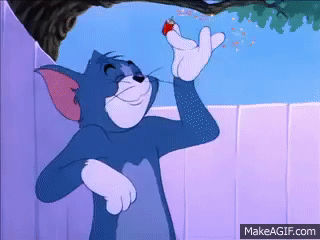
Genre Research
What makes a good comedy drama film?
A good comedy-drama film should occasionally balance their humor with more dramatic and humanistic moments.
Comic Timing
The use of rhythm and tempo to enhance comedy and humor. The pacing of the delivery of a joke has a strong comical effect.
An example of this would be Charlie Chaplin's "The Circus" where the rhythmic orchestral music highlights the chase scene and the hits that the protagonist and antagonist exchanges while acting as puppets from the police.
Slapstick
Slapstick is an element in Comedy which involves the over-exaggeration of physical violence.
An example of this is a cartoon called “Tom and Jerry” where the montage of violent exchanges between the two are viewed as playful "banter".
Pregnant Pause
A pregnant pause is a technique of coming timing used to highlight a comedy element.
An example of this would be Mr. Bean's "Car crushed by Tank" episode in which the silence of enjoying his brownie accentuates the comedic contrast of loosing his car to a tank.


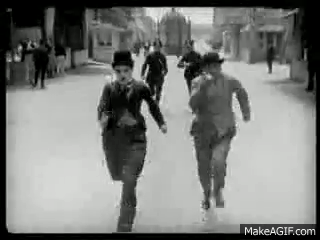
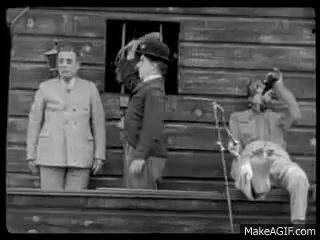
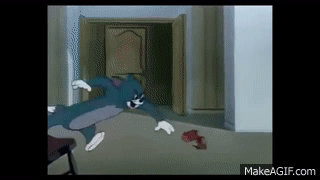





Research; Understanding the stance and direction of our film will be helpful by studying the potential genre's codes and conventions, and any techniques we may be able to refer or base on while filming, to carve the genre's characteristics within the film.
Reflect; Looking into the three main aspects of the comedy genre, GRATIFLY will greatly benefit with this bank of reference and basis when the dream team and I are in need of creating a comedic moment during planning or production stages of the film.
Relate; Applying the conventions to a rough plot of the film, the technique of comic timing will play a huge role in shaping the film and especially to build a character profile and impression of the protagonist to the audience. As a visual and musical person, as well as a rhythm-based editor, I rely heavily on this technique in creating mood, meaning and often laughter. A definite application of this technique will be seen in the entrance shot- the protagonist walks in school with a yet undecided song to suggest his happiness, as well as later in the sixth form centre establishing shot to Handel's Hallelujah Chorus. Both instances will then be interrupted by a "disk scratch" sound effect, paired with the diegetic sound and animation of the gratiFLY, who will buzz and disrupt the gratification sources from the protagonist. This interruption may make the audience laugh which only adds more colour to the intended comedic profile of the scene and overall film.
However, breaking a convention, arguably the most well recognised technique of slap stick will be abandoned physically; only the diversion of something to create comedic moments will be kept, but no physical or explicit violence is to be involved. Instead of the exaggerated coercion, we chose to maintain a heavily implied consent of an animated fly representing the social force of the power bloc disrupting the protagonist's happiness from his gratification sources.
On the other hand, Pregnant pause will be the most featured technique in the film during times of recognition (see Todorov Narrative Theory below), where the protagonist is to realise a mistake he's made or specifically how he has bitten and literally consumed a mobile phone, representing the average media platform consumer in a comedic way.
THE SIX ELEMENTS OF DRAMA
ACCORDING TO ARISTOLTLE
PLOT
Character
Thought
DICTION
MUSIC
SPECTACLE

TODOROV
NARRATIVE THEORY
Research; Now understanding the direction of the film in terms of genre, the structure of the film should be decided and applied to be able to start creating a stable and firm narrative.
Reflect; Using Todorov's theory in GRATIFLY, the 5 stages will serve as great starting points of discussion in planning stages, and act as the "glue" to piece any initially left out but intended scenes into places of the film to give closure.

Relate; Following some aspects of Todorov's narrative theory;

The EQUILIBRIUM is kept, where in the entrance scene, the protagonist enters the school and sixth form centre in a calm manner and in rhythm of the music, with the mise en scene of a satisfied face.
The DISRUPTION in the film occurs implicitly during the interruption in the entrance scene at the door, but the explicit and physical disruption appears in the food scene, where the protagonist is literally faced with an obstacle of eating a mobile phone to consume media forms. This becomes the first noticeable obstacle.
The RECOGNITION arrives during the social scene, in which hallucinations of himself conforming with the 'perfect boy' serves as the final strike to his revelation of an existing and legitimate antagonist of the invisible yet powerful society figure.
However, breaking the structure of the theory, the film does not experience a full REPAIR of the situation, even when physically confronted by the possessed toilet and spraying the toilet with an anti-bacterial gel representing purity, the fate of the society entity and the verdict of the battle remains unclear.
Finally, the dream team has decided to not give any form of RESTORATION in the film. This provides the intended reinforcement of the dominant ideology in which society and the power bloc are always superior and inevitable to defect or hide from. This also serves as a cliff hanger which is commonly seen in modern drama films.





TREATMENT
of GRATIFLY (2017-18)
The

Title of Film: Gratifly
Production Company: RyuTecha Productions
Genre: Comedy
Duration: 4:30 minutes
Synopsis: A new student approaches a school. He is confident in the freedom and livelihood he possesses at first, before having to reluctantly conform to the rules and norms of society that makes up the hegemonic structure of the school. And although he challenges this, he faces punishments physically, socially and emotionally for not conforming.
Message: We are always under the control of those higher than us in society.
Characters:
Richy Srirachanikorn as ‘A Boy’
Toy Homsiri as ‘The Security Guard’ and ‘Another boy’


Have you stolen another person's idea?
Not stolen, but referred, inspired, or developing by. All media is other media in a way.
Will you use copyrighted material?
Potentially, however this will be tackled through the creation of Ryu’s own cinematography of timelapses that may be needed as transitions in the film, and Richy’s compositions at points of time where specific music is needed, but may be costly or damaging to us as a production team; i.e. plagiarism of intellectual property.
Is your film offensive?
To an extent, everything in media can be considered offensive. It is up to the audience’s and conglomerate’s preferred reading of the representation. However, we believe that our media product- a short film- will not be offensive to the mainstream audience, because we do not discriminate opposite gender or ethnicities, nor showing any explicit violence and prejudice.
Does your film put anyone in danger?
The media product we are making involves a protagonist of a student becoming exposed into the world of power blocs and conglomerates. He becomes increasingly vulnerable in each stage of gratification sources, which is represented by a student’s daily routine in a day at school. The power blocs manipulate his actions into conforming to their preferred reading of how it should be done, and although the protagonist challenges this, the society entity punishes him physically and emotionally for being an outcast of society he is in.


Budget and Resources





AVAILABLE BUDGET: 10,000 THB
- 2000 THB
- 1000 THB
- 700 THB
- 300 THB
REMAINING: 7,000 THB at the very least




Prop List : Table of Items

"A SMALL ISSUE..."
Luck was truly in our favour, as the new masks had just arrived (earlier than they were supposed to), and that the Head of Drama had been kind enough to lend them to us fresh from the box with full trust (hence needing to use them for GCSE exams and the school production!)
I guess this was an operation well covered-up!
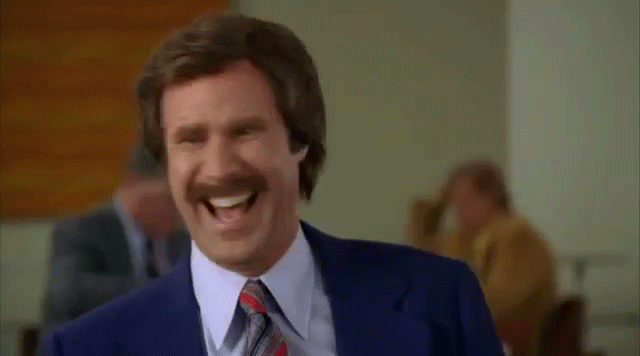


One of the most anticipated and prominent prop we needed were the masks. I had personally drafted and revolved the social scene around the presence of these props to accurately create meaning we wanted to with society.
However, trouble struck as we figured out a day before production of this shot that the masks initially available to be used were no longer free. Therefore, thinking on the spot, I resorted to contacting my drama teacher for allowance to borrow, and commissioned Toy's behalf as he was officially prop master.




Group Casting


At the point where practical issues are addressed and planned, such as the budget and treatment, the focus is now on the design and style of the film: the actors. Group casting is employed to detail the progress, reflection and success of carving the perfect roles appropriately.


Richy Sririachanikorn - CASTED
for the main protagonist role of
A BOY

Lewis William John - REJECTED
for the main protagonist role of
A BOY

Toy Homsiri - CASTED
for the secondary antagonist role of
THE PERFECT BOY

Dan Simpson - CASTED (REMOVED)
for the role of
A NICE TEACHER
GROUP RELEASE FORM: casting and informed consent

Pictured above are the cast and crew of THE DREAM TEAM, a division of RyuTecha Productions, who is legally responsible for creating and agreeing to the casting consent form (attached right).

The most accurate photographic representation of a frustrated and confused Richy in reluctantly signing his permission for the google-doc created casting form, given to him by a suspicious acting Toy...

OFFICIAL CALL SHEET
GRATIFLY (2018)'s CAST and CREW
As executive producer and director, I have to manage and maintain the visual and meaningful side of the film, but also the practical and physical side.
With this, Ryu had devised and formed a template of an information sheet which was filled in with relative information of the fim to create a CALL SHEET for the crew. The call sheet includes such vital information of the time, weather, date, notes, talents and production roles.




The call sheets proved to be successful in providing the correct and reliable information for cast members to arrive on set promptly with enough emotional awareness to accurately perform in role, for the crew to retrieve the required equipment to reach the satisfactory standard of the scene, and especially for myself as director to go over the rough highlights of the scene the night before shooting at 2am!! These really do help!










STORY BOARD
and
FILM REFERENCES
and
SHOT TYPES


The story board details and outlines the plot visually and literally for the cast and crew to position, interpret and act out accordingly. The story board for GRATIFY is at least 10 pages, with more than 100 frames in total, and contains sketches that I had drawn out that best represent my interpretation of the scene. In addition, there is a small notes section below each frame which contains the brief description of the shot and the appropriate cinematography technique to be used. Arrows and different colours are also used to interpret meanings for the cast and crew.
Below are some examples of the story board using film making terminology and film references or inspirations including their shot types and specific types of micro-elements.











THERE ARE TWO PAGES TO THIS STORY BOARD GALLERY! -->
For Audio Recording and Design, please refer to DEVELOPMENT OF SKILLS and scroll down to the sub-section titled "Amazing Audio" to understand my development of understanding in the realm of folly design and its implication in GRATIFLY.
SHOT TYPES




THE SCRIPT







A Happy Protagonist
In the opening of this comedy, I am trying to achieve the meaning of utmost confidence which is not conventional or belonging to a group of people, but to one self in his own independence of freedom and will, through the representation of a charismatic, energetic, and vibrant protagonist.
The micro element used will be of non-diegetic sound of The Turtles - So happy together to suggest a modern and upbeat introduction that will highlight the confidence the protagonist has through his confident pose and charming walk. With this, meaning of the protagonist's control will be suggested through the editing of match on action of cinematography of tracking shots and extreme close-ups that the protagonist is in tune with the music and is ultimately in control of this sequence where the editing responds to his actions, the cinematography worships his attractive aura and the mise en scene that intensifies this confidence, as well as the non diegetic song revolving around his presence on film.
Frames 1 - 6; 40 seconds
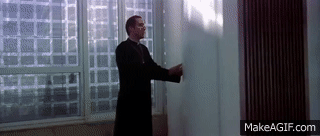
Saturday Night (1977)
Similar editing and cinematography of the tracking will be used in GRATIFY to create a n interpreted creation of this scene.
Face Off (1997)
Possibly, there may be a tracking high angle shot used later in the entrance of the protagonist into the sixth form centre as a way to paint more confidence in the character and suggest an establishing shot, too.
refer to 0:26 - 0:43 for use
FILM REFERENCES: APPLICATION TO STORY BOARD




The Dolly Zoom to Society
Frames 69-70; 7 seconds
This part of the film tackles the confrontation that the protagonist will have of the physical form of society, being groups of people in our preferred reading of sections of society in the stereotypes held (nerds, jocks etc.). As the protagonist struggles to fit in and break the awkward position he is in, exposed through the vast composition of him tilted to the left side of frame 66 (suggesting instability), and the high angle shot provokes his state of power as being engulfed by the groups of people around him (frame 67, worm shot worshipping a group of people representing society).
The highlight of this scene is the moment in which the protagonist finds a potential group to join and blend in, standing only a few feet from him. To show his excitement and awe, the Dolly Zoom will be employed here to accentuate his mise en scene- shocked expressions, with non diegetic music of a dramatic sound effect.
Adding a touch of comedy, as is the genre of the short film respectively; the POV shot of the protagonist looking to the group in frame 70 will contain the editing of a circular hole that narrows down to the group ahead. This comedic technique is borrowed and inspired from cartoons at the ending of each episode.To some relatable viewers, this may not only remind them of a comedy mood that is intended to be made, but may also match their stereotyped use of the circular hole that something is coming to an end, like the cartoons, in which this case it may soon be the end of protagonist's struggle with the superior society, hinting defeat.





Jaws (1975)
To dramatize the intensity of the discovery of group that the protagonist can belong to.
Tom and Jerry (1940-)
The signature motif to suggest "closure".


Karate Kid (2010) Insiprations
Frames 8-18; 30 seconds
After watching Karate Kid (2010) as a dinner movie a few nights back, one specific sequence of shots in the film gave me a eureka moment that formed and stabilised the physical representation of the protagonist's first encounter of authority with the school gate and the guard in a hegemonic structure.
The intended cinematography is of a eye-line shot that sees the protagonist on the edge of the composition to suggest instability, after the streak of his confidence earlier on is broken off.
The visual representation of a cage covering his physique will suggest the meaning of suggested entrapment or self-conflict between his powerful and free personality, versus the manipulative and controlled system of society that he is about to set foot into.
The composition of Karate Kid (2010)'s gate of the school is of a broad, ancient, and rather prison-like. Luckily, our school's gate share a similar shape and size, as well as being grey, which can be associated to dullness, according to Putchink's Colour Theory.





The two shots between the authority of the guard and Dre with the girl will share a similar appearance in my short film, between the trapped protagonist and the security guard on post as representation of a division from the conglomerates of society.
The guard in my short film however, will be positioned standing and seen from a worm shot to suggest superiority. In terms of mise-en scene, the face of the security guard will not be clearly visible to the audience to suggest their incapability of understanding and reaching the same level as the power bloc, giving the preferred reading to the audience that they are seen by the film makers as the lower class, in the same position as the protagonist.
Inspired and influenced from Karate Kid (2010), will be the shot of guard exchanging physical tension with the protagonist in a similar manner of cinematography and editing.

An adaptation of Karate Kid (2010) to GRATIFY will be the use of the low canted angle towards the school gate to suggest its dominance.
Adapted, the protagonist will be positioned on the right side of the composition as an over the shoulder shot to visually suggest the metaphor of the school being a burden on his shoulders, as well as demonstrating the inferiority the boy poses to the symbol of a controlled society.


Entrance to the Dining Hall
Frames 19-21; 12 seconds
Acting as a transition between the introduction into 'ACT I - Food Gratification', the meaning intended to create is of the protagonist regaining control and power from the earlier vulnerability shown in the introduction. Another risk we are taking apart from the dolly zoom, is the crabbing shot and jib shot.
In frame 20, a bird's eye view of the protagonist walking down the steps employs the surveillance and voyeuristic factor from Blumler and Katz's 'Uses and Gratifications Theory' (1974). This creates a sense of vulnerability in the hunted and spied-on protagonist. With this, as he steps further down, he becomes physically smaller, and therefore acts as another representation of becoming a smaller importance in the society of large and powerful power blocs.
A jib shot will be attempted to pan in a medium shot of the protagonist walking down and towards the lunch queue, all while becoming exposed in the large establishing shot of the dining hall around him; he is engulfed within society.

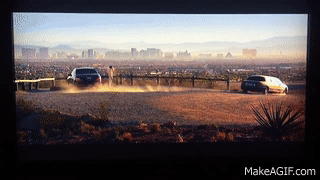
The Hangover Part III (2013)
Exposing character to space while giving an establishing shot.
The Stand(sit)- off of Doom
Frames 112-114; 10 seconds
Focusing the film back into the genre of comedy in the midst of a climatic build-up prior in the other gratification sources, the protagonist must face the toilet- a physical form of the society entity.
Inspired by The Good, the Bad and the Ugly (1966), a specific sequence is borrowed in the final stand-off between the main characters in the dessert, before Blondie (Eastwood) shoots and kills the antagonist. As a contrast of mood and tone, the reference will become clear to revised audiences and shed a comic touch to the supposed stressful and dramatic scene.

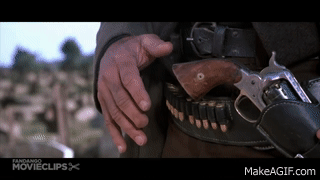
Originally taking the idea for only the action of the staring in this three-way stand-off, we have decided to accentuate on the reference by adding (post production) black bars which will animate and move to highlight the eye line shot of each character.
The quick cuts and big close ups are also another reference which will shape the toilet scene's climax. The intended outcome is to create tension and excitement, through quick cuts of extreme close-ups with the digital black lines which will serve perfect for when the protagonist in GRATIFLY shoots the toilet.

ACTION
GREAT IDEAS INTO
making media from the mind into the media
THE 'MASKS' PEOPLE
Audience Demographics Representation
Wanting to touch on the topic of the demographic representation of our mainstream audience, the aspect of LIFESTYLE was chosen to be focused on from the L'CAGES model.
As the main actor and director, I have to perform and choreograph the visual performance of the mask people, who are branded by conglomerates (company logos), the preferred readings by media representation and dominant ideologies of what makes a fat and lazy demographic who consumes products from food chains, or someone intellectual to an extent to purchase technological products.
Positioning myself in various body languages of stance, body language, posture and hand gestures, I tried my hardest to convey these stereotypes physically.



The Intelligent and conservative character - the maintaining of the hand clenching in an upright position aims to create an impression of a polite and calm mannerism that an intelligent consumer of technological product SAMSUNG would or may buy. BOOTS is also a pharmacy chain; the hands are kept away from dust to contain cleanliness and order.

The Hungry Demographic
Sitting in the laid back position of hand over stomach aims to covey the finishing of a meal of the restaurant/food stores.

The Athletic Demographic
Excessive in physical and visual space, the character flexes throughout, taking up space to show dominance. The hand on knee wide stance suggests the eager energy of an Adidas Sports user.



The Super-Conglomerate - the two biggest companies within the labelled masks people; most powerful, wealthiest and arguably most popular. The intended meaning to create is through a confident body language in an laid back but stable posture of sitting, the authority of the company over others through the physical metaphor of over-hearing other conversations as a form of invasion and dominance. Its hand are similar to the Boots and Samsung position of stability and self-integrity.
GOOD BAD AND UGLY
Western Shootout Reference
Ever since the beginning of this film's creation in its very initial planning stages, a specific vision stuck with me, and is the sole reason to why there was a toilet scene created for this comedy. Having watched the classic film a few days prior to discussing the premature coursework's directions, the dream team went through multiple debates, plans, storyboards, blocking and visual simulations of how long, what angle and the amount of reference to be included and incorporated.
Despite rough start-ups to unanimously visualize the scene as the crew and cast, we had eventually got there. With the theme music of The Good, the Bad, and the Ugly (1967) over the scene, as well as the direct big close-up zoom on the duals, the direct reference of the three way stand off in the western is reflected on the emphasis of the stare off using digitally added black bars to accentuate the eyes. The metaphoric pistol in the cowboy film is represented by the bottle of windex, with similar hand movements as the protagonist.
This touch of film reference worked better than we thought, and took the appropriate amount of time, in our opinion, to suggest the reference and add the comedic factor during the film's climax.





The Gun Metaphor
Aiming to symbolize as a weapon of peace as it is used by the protagonist in both films, I decided to use a bottle of a multi-purpose cleaning liquid. Used against a toilet, it correlates to a definite opposite (dirtiness v.s. cleanliness) as a latent meaning in surfacing antagonist and protagonist conflict. However the deeper manifest may hint the cleaning of corrupt dominant ideologies.

A GRAND ENTRANCE
Capturing Confidence
Initially a non-serious idea in the discussions, I saw potential within the long term effects that the scene can give to the story in viewing and beyond. Wanting to capture the essence of gradual loss of power in the protagonist taken from society, the need to capture the great confidence of the protagonist is essential.
Accidentally tumbling across a video clip online, I had found the perfect scene needed in Nicholas Cage's absurdly 'excessive' demeanour in Face Off (1997)'s opening sequence.
This was it, I thought.
Excited, I pitched the idea to the dream team that the BOY had to be shown as over-confident, to the slight exact degree in Cage's performance. He had to be 'out of this world' happy, and unknown to fear or the norms and rules, and the dirtiness and irony of society's corrupted dominant ideologies and judgmental preferred readings by labelling people.
Through discussion of different approaches to the reference that boosts the comedic factor of the film and deepens character development of the protagonist, we decided that an exact replica of the scene worked best for everyone, and it was not too long to take up too much time.
Everything worked out in the effortless 2 takes, one for real and another for insurance. We are happy this worked out into film, especially me and Mr. Cage, I imagine!

